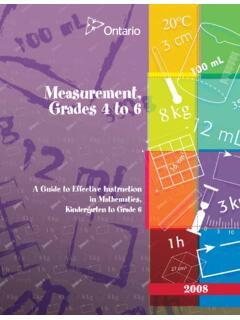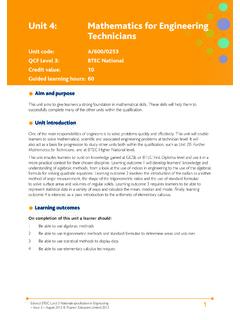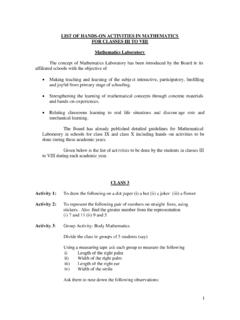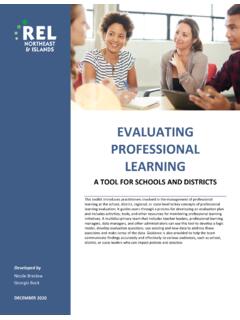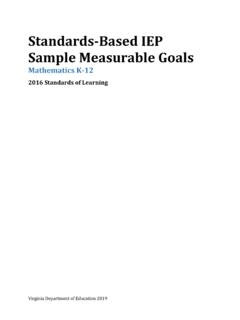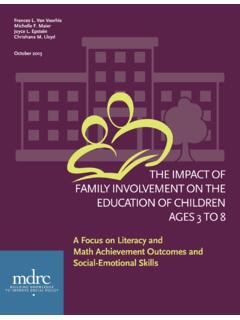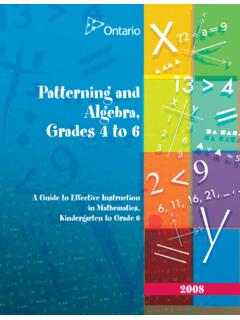Mathematics Learning Activity Types
Found 13 free book(s)Measurement, Grades 4 to 6 - Eworkshop - L'Atelier
eworkshop.on.caThe second part of the guide provides sample learning activities, for Grades 4, 5, and 6, that illustrate how a learning activity can be designed to: • focus on an important curriculum topic; • involve students in applying the seven mathematical processes described in the mathematics curriculum document;
Unit 4: Mathematics for Engineering Technicians
qualifications.pearson.comthree different types of function by differentiation and two different types of function by integration. PLTS: This summary references where applicable, in the square brackets, the elements of the personal, learning and thinking skills applicable in the pass criteria. It identifies opportunities for learners to demonstrate
What Is a Statistical Question? (Teacher Version)
www2.census.govThe following items are part of this activity and appear at the end of this student version. • Item 1: Radio Set Ownership Map • Item 2: Map of U.S. Regions and the Land Areas of the 50 U.S. States and District of Columbia Student Learning Objectives • I will be able to distinguish between statistical questions and other types of questions.
LIST OF HANDS-ON ACTIVITIES IN MATHEMATICS FOR …
edudel.nic.inActivity 7: To make a time scheduler from wake up time to bed time on a working day and a holiday. Activity 8: To represent multiplication tables, from 2 to 5, using lines and dots by an activity method. (Us e stickers to represent dots) Activity 9: To identify a number as an even number or an odd number, b y making pairs of beads/ pebbles ...
EVALUATING PROFESSIONAL LEARNING
ies.ed.govMar 11, 2020 · content supports teacher learning within teachers’ classroom contexts. This element includes an intentional focus on discipline-specific curriculum development and pedagogies in areas such as mathematics, science, or literacy. • Incorporates active learning: Active learning engages teachers directly in designing and trying
California Common Core State Standards
www.cde.ca.govThe standards call for learning mathematical content in the context of real-world situations, using mathematics to solve problems, and developing “habits of mind” that foster mastery of mathematics content as well as mathematical understanding. The standards for kindergarten through grade 8 prepare students for higher mathematics.
Science Concepts Young Children Learn Through Water Play
www.hookedonscience.orgtrators push for more well-defined assessments of learning, teachers need to be able to clearly articulate the specific concepts children learn during all types of play. This article identifies the science concepts involved in a variety of water play activities and the teacher-mediated learning process that can accompany and enhance this learning.
The HighScopre Preschool Curriculum
www.nj.govThe Numbers Plus Preschool Mathematics Curriculum is a comprehensive set of detailed plans for small- and large-group early childhood mathematics activities, with ideas for extending learning throughout the program day. What’s special about Numbers Plus is that children’s mathematical learning is sequenced within
Common Core State StandardS
www.corestandards.orgMathematics experiences in early childhood settings should concentrate on (1) number (which includes whole number, operations, and relations) and (2) geometry, spatial relations, and measurement, with more mathematics learning time devoted to number than to other topics. Mathematical process goals should be integrated in these content areas.
Standards-Based IEP Sample Measurable Goals
www.doe.virginia.govGiven a grade level activity, the student will identify, sort and classify quadrilaterals based on their properties 85% of the time in 4 out of 5 trials by the end of the second grading period. Strategies/Ideas for Instruction Mathematics Instruction Plan: Classifying Quadrilaterals Foldables Journal writing
THE IMPACT OF FAMILY INVOLVEMENT ON THE EDUCATION …
www.mdrc.orginvolvement in children’s learning and development through activities at home and at school affects the literacy, mathematics, and social-emotional skills of children ages 3 to 8. A total of 95 studies of family involvement are reviewed. These include both descriptive, nonintervention
Patterning and Algebra, Grades 4 to 6 - eWorkshop
eworkshop.on.caIntroduCtIon Patterning and Algebra, Grades 4 to 6 is a practical guide that teachers will find useful in helping students to achieve the curriculum expectations outlined for Grades 4 to 6 in the Patterning and Algebra strand of The Ontario Curriculum, Grades 1–8: Mathematics, 2005. This guide provides teachers with practical applications of the principles and theories that
Kindergarten through Grade 12
www.nj.govThe New Jersey Student Learning Standards for Science (NJSLS-S) describe the expectations for what students should know and be able to do as well as promote three-dimensional science instruction across the three science domains (i.e., physic al sciences, life science, Earth and space sciences). From the earliest grades, the expectation is
Similar queries
Measurement, Grades 4 to 6, Learning, Learning activity, Mathematics, Types, Statistical Question, Activity, Statistical, EVALUATING PROFESSIONAL LEARNING, Common Core State Standards, Science Concepts Young Children Learn Through Water, Mathematics learning, Standards-Based IEP Sample Measurable Goals, Patterning and Algebra
